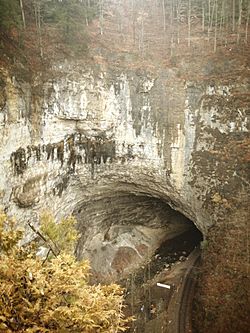Natural Tunnel State Park facts for kids
 |
|
| The Natural Tunnel, still in use as a railroad tunnel | |
| Overview | |
|---|---|
| Location | Natural Tunnel State Park, Scott County, Virginia, United States |
| Coordinates | 36°42′11″N 82°44′35″W / 36.703°N 82.743°W |
| Operation | |
| Owner | Commonwealth of Virginia |
| Operator | Norfolk Southern Railway |
| Traffic | Coal Haulage |
| Character | Naturally formed limestone cave converted to a railroad tunnel |
| Technical | |
| Construction | 1893 |
| Length | 838 feet (255 m) |
| Gauge | 1,435 mm (4 ft 8 1⁄2 in) |
| Electrified | No |
| Tunnel clearance | Portals: 50 feet (15 m) Max: 80 feet (24 m) |
Natural Tunnel State Park is a Virginia state park that has an amazing natural wonder. It's home to the Natural Tunnel, a huge cave made by nature. This cave is so big that it's even used as a railroad tunnel! You can find it in the Appalachian Mountains near Duffield in Scott County, Virginia.
The Natural Tunnel is really wide, up to 200 feet (61 m), and tall, about 80 feet (24 m) high. It started forming over a million years ago. This happened when rainwater, which has a weak acid in it, slowly seeped through cracks in the ground. Over time, this water dissolved the limestone and dolomite rock. A small river, now called Stock Creek, was then pulled underground. This creek kept carving and shaping the tunnel for thousands of years.
If you look closely at the tunnel walls, you might see signs of ancient life. Many fossils have been discovered in the creek bed and within the tunnel's rocky walls.
Contents
How the Natural Tunnel Formed
The Natural Tunnel cuts through a place called Purchase Ridge. This ridge is made of a type of rock called limestone. The tunnel itself began to form during the Pleistocene Ice Age. Over millions of years, water slowly wore away the rock, creating the large opening we see today.
A Look at History
Legends and Early Discoveries
There's a sad but popular legend about the Natural Tunnel. It tells of a Cherokee maiden and a Shawnee warrior. Their tribes wouldn't let them marry, so they jumped to their deaths from the highest point above the tunnel. This spot is now known as Lover's Leap.
People have been visiting the Natural Tunnel for a very long time. It's said that Daniel Boone, a famous explorer, was the first European to see it in the 1700s. Later, in the early 1900s, William Jennings Bryan, who was a Secretary of State for the United States, even called it the "Eighth Wonder of the World"!
The Tunnel as a Railroad
The Natural Tunnel State Park was officially created in 1967 and opened to visitors in 1971. But the tunnel itself was used much earlier. In 1893, the South Atlantic and Ohio railroad built train tracks right through the Natural Tunnel. The very first train went through the tunnel the next year, in 1894.
At first, the railway carried passenger trains, meaning people could ride through the tunnel. Today, the train line is still active, but it's now operated by Norfolk Southern. Another company, CSX, also uses the tracks. Now, the trains mostly carry coal through the tunnel.
What to Do at the Park
Natural Tunnel State Park offers many fun activities for visitors. There's a 1,600-foot (500 m) boardwalk that makes it easy for everyone, including those with disabilities, to get close to the tunnel.
Besides seeing the tunnel, you can also go camping, swimming, or have a picnic. There are many trails for hiking, and a visitors center to learn more. The park also has natural amphitheaters, which are like outdoor theaters, some as high as 600 feet (180 m)!
Natural Tunnel State Park Trails
| Trail Name | Length | Difficulty |
|---|---|---|
| Tunnel Hill Trail | 0.7 miles (1.1 km) | Easy/Moderate |
| Tunnel Trail into Gorge | 0.3 miles (0.48 km) | Difficult |
| Lover's Leap Trail | 0.4 miles (0.64 km) | Moderate |
| Gorge Ridge Trail | 0.5 miles (0.80 km) | Moderate |
| Purchase Ridge Trail | 1.1 miles (1.8 km) | Difficult |
| Spring Hollow Trail | 0.3 miles (0.48 km) | Difficult |
| Birding and Wildlife Trail | 0.7 miles (1.1 km) | Moderate |


